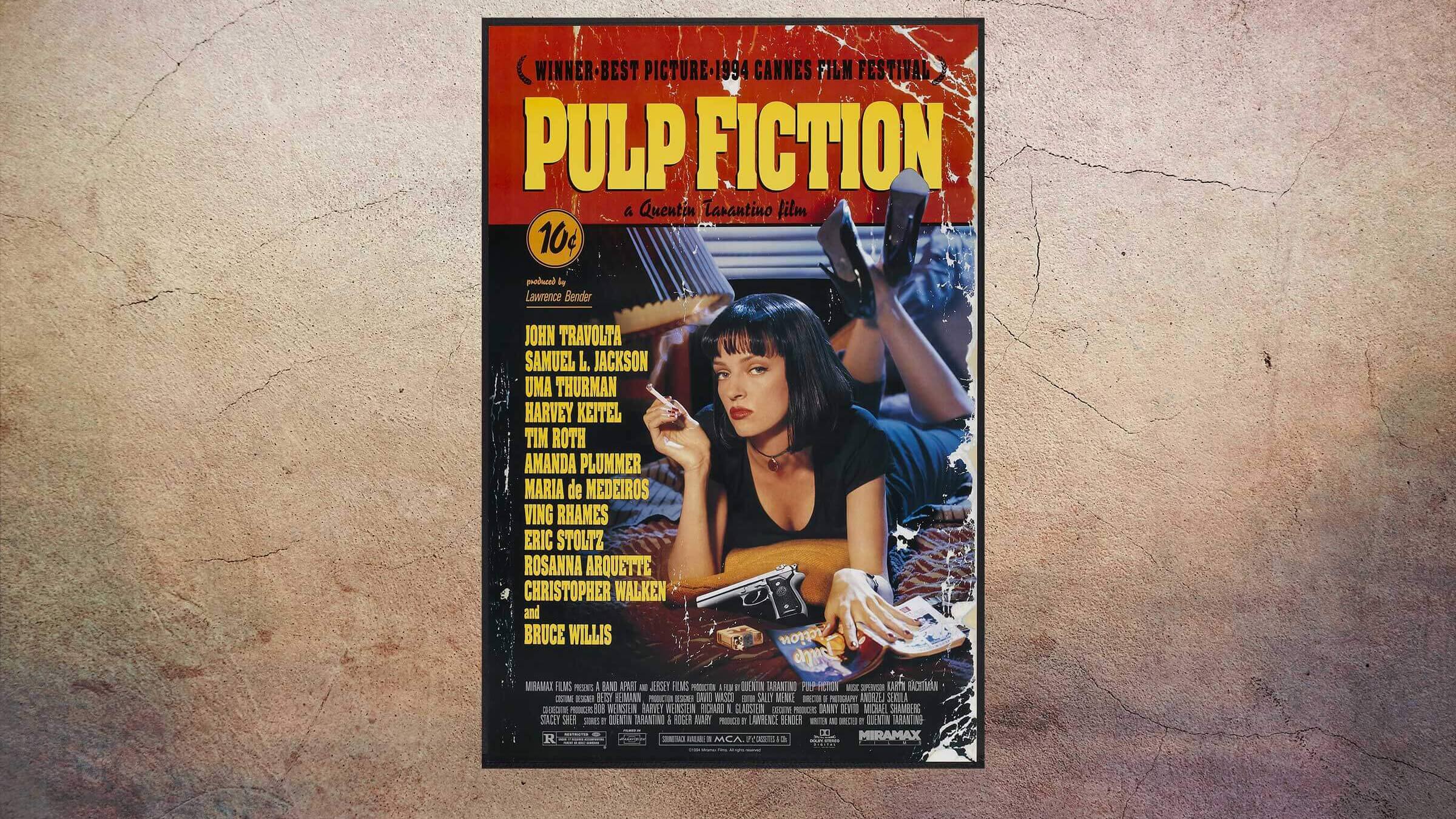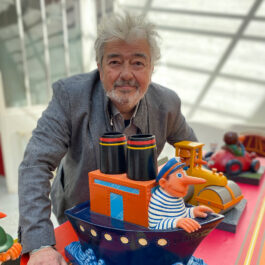25 years ago this month, a film was released that would make an impact on all who saw it. Pulp Fiction, the second film from Quentin Tarantino, was a slick dive into an underground world of hitmen, drug dealers, crooked boxers and love-struck diner robbers. Told in non-linear chapters, it was a stark and refreshing take on cinema during a decade which saw Hollywood in a state of flux. Teetering on the edge of a digital future, the film was a reminder of the techniques that had gotten us this far.
A quarter of a century on, it’s still considered one of the finest movies ever made. But why? Here’s what we believe makes this film timeless…
The Rebel With A Cause
Recent hit Once Upon a Time… in Hollywood showed that Tarantino is still a giant of cinema, even at a time when the only films that seem to find success involve superheroes or big explosions. Back in ‘94, however, his legacy was not yet assured. His first film, Reservoir Dogs, was a creative success, but had not found an audience in America (the film did far better in the UK, where the controversy of the infamous ear cutting scene drew curious cinema fans). His next film would be his most important, but to change his future, he would look to the past – particularly pulp magazines which told episodic crime stories.
“The idea for Pulp Fiction was the idea of taking the pulp genre, as represented in magazines like Black Mask,” Tarantino said in an interview with the American Film Institute. “So the idea in the case of Pulp Fiction is to take three separate stories, and make them be the oldest stories in the book: Vincent’s character, the hoodlum, has to go out with the boss’ lady, but don’t touch her! In the case of Bruce Willis’ story, the boxer’s supposed to throw the fight, he doesn’t, and now the mob’s after him.” The third story would be a departure from the archetypal movie hitmen. “I thought ‘what happens if we hung out with them?’” Tarantino explains.
What would happen is an unforgettable mixture of violence, pop culture, humour and intrigue that would earn the then-31-year-old Tarantino both the Palm D’Or and an Academy Award for Best Original Screenplay.
Breaking Down A Masterpiece
The beauty of the film is that it immerses you in a fantastic world of Tarantino’s creation. We start out in an ordinary-looking diner, where two criminals (Tim Roth and Amanda Plummer) are chatting in a casual fashion. Out of nowhere, they decide to rob the very diner they are in – the unmistakable theme tune starts, and we are taken from the ‘real’ world to the ‘reel’ world of Pulp Fiction.
Now we’re at a retro apartment complex, following the mundane conversations of hitmen Jules Winfield (Samuel L Jackson) and Vincent Vega (John Travolta), discussing fast food and foot massages before enacting horrific violence. We stay with Vincent Vega as he takes his boss’s wife Mia Wallace (Uma Thurman) out for the evening, with his best intentions thrown into chaos by an accidental overdose. We then meet boxer Butch (Bruce Willis), whose girlfriend Fabienne (Maria de Medeiros) forgets his father’s antique watch, leading to a hazardous journey across LA. Finally, we are taken back to the diner where several of our characters’ paths cross in one unforgettable end sequence.
While the timelines are fragmented, the reason for the film’s quality runs steadily through the heart of the movie: Everyday tasks carried out in a fantastical world by larger-than-life characters, leading us to misadventures that can be exciting, scary and hilarious in equal measure. It introduces us to characters who are more than the sum of their parts – in another film, Thurman’s Mia would be a two-dimensional gangster’s moll. Here she’s an intelligent, powerful character who is very aware of the authority she holds over Vincent. Amid the swearing and shouting, Jules is deeply philosophical, seeing a near-death experience as a sign that he must be ‘The Good Shepherd’ mentioned in the Bible. Even Butch, who is dismissed as an oaf, runs deeper than his employers expect. “That’s how you’re gonna beat ’em, Butch. They keep underestimating you,” Willis says to himself at one point.
Like its characters, Pulp Fiction is far more than it appears to be on the surface. Inspired by the movies that the director grew up adoring, the dialogue leads you down an unexpected path, rather than signposting what’s coming like so many Hollywood movies do. Nothing is just for show – while the sights and sounds are entertaining, no word of dialogue or piece of set is out of place. Everything has a purpose, nudging you toward the next part of the story. It’s an exceptionally made film, born of a lifetime of cinematic study and a devotion to making every frame an artwork in itself.
An Indie Revolution
The film was an enormous smash hit around the world, making $213 million (around $368 million today) from an $8 million budget. Culturally, it wove a number of catchphrases and iconic moments into the zeitgeist. The image of John Travolta and Uma Thurman twisting at Jack Rabbit Slim’s restaurant is instantly recognisable; while a generation of film fans developed a surprising knack for reciting scripture while quoting Jules Winfield’s favourite Bible passage. In an interview in June 2019 on American TV’s The Today Show, Samuel L Jackson remarked that fans still quote lines to him: “‘Do you know what they call a quarter pounder with cheese in France’ – that’s the most popular one with a certain age group.” Considering Jackson has appeared in over 150 films, that’s quite some impact.
More than that, it pushed forward a sea change in the types of films being made in the 1990s. New directors like Paul Thomas Anderson, Darren Aronofsky and Spike Jonze were given a platform to debut on a larger stage than they might have, while Tarantino’s contemporaries such as Kevin Smith, Robert Rodriguez and the Coen Brothers could push ahead with riskier subjects, given that edgy cinema was in fashion. While they may not be exactly the same style, films like The Big Lebowski, Boogie Nights and Fight Club benefitted from an audience hungry for a different kind of storytelling.
The A-List Revival
One of the most notable factors of Pulp Fiction was the career it both started and revived. Samuel L Jackson was a busy character actor at the time, offering memorable support in films like Jurassic Park and Do The Right Thing. However, his infamous ‘Ezekiel 25:17’ speech would thrust him into leading man territory, with religious assassin Jules Winfield showcasing Jackson’s sheer power on screen. It’s a legacy that continues in modern movies, with a Pulp Fiction reference in the Jackson-starring Marvel film Captain America: The Winter Soldier.
It’s here that Tarantino also earned his reputation as a man who could revive ailing careers. Bruce Willis was reeling from a trio of box office disasters (Hudson Hawk, Striking Distance and family film North) when he was cast as Butch, a boxer with daddy issues and a fractious relationship. The performance showcased a different side to Willis – quieter, more considered. It rebooted his career, with hit movies like 12 Monkeys, The Fifth Element and Armageddon soon following.
However, none benefitted more than John Travolta as thug-on-a-date Vincent Vega. The character was an anti-star: Travolta was overweight, with a greasy ponytail and a hunched posture. He was a million miles from Saturday Night Fever or Grease. Yet even in this role, he reminded audiences that the actor is cool. Effortlessly cool. Whether holding a robber at gunpoint in surfer shorts or saving Mia from an overdose, he had a magnetism that made Hollywood take notice again, prompting decades of success for the actor. At the time, however, he presented a risk. “I wanted John, but his career was not in a great place,” Tarantino recalled in an interview with actor Jamie Foxx. “(The producer) was like ‘I don’t want him,’ but I remembered what a great movie star he was, and how exciting he was.” He pushed for Travolta over the studio’s choice, Daniel Day-Lewis, and the result was one of the actor’s most important performances.
Inspiring The Next Generation
Quentin Tarantino has a very unique voice, but that’s not to say it can’t inspire others in their own art. There are certainly shades of his influence in the work of film-makers such as S Craig Zahler (Bone Tomahawk, Dragged Across Concrete), and Irish film-making brothers Martin and John Michael McDonagh (In Bruges, Seven Psychopaths, Three Billboards Outside Ebbing, Missouri).
He’s also influencing the next generation of actors, who are lining up to work with him. Austin Butler, the young actor who worked with him on Once Upon a Time… in Hollywood as one of the Manson family murderers, remarked that the director’s reputation meant he was willing to take risks. “The role itself requires me to dig into human things that are conflicting,” he told Variety. “I would have a lot more reservations about doing it if it wasn’t for Tarantino. The fact that he creates a world of his own, it’s such a joy to be a part of.”
Tarantino has said many times that his next film, his tenth, would be his last feature. By then its likely his influence will have been felt over three decades of telling the stories he wants to tell, but when the book finally closes on his time as a film director, you can bet this 1994 masterpiece will be considered first among his achievements.














Sorry, the comment form is closed at this time.